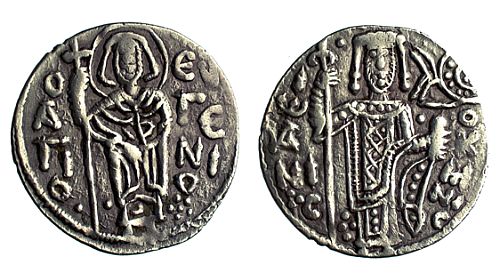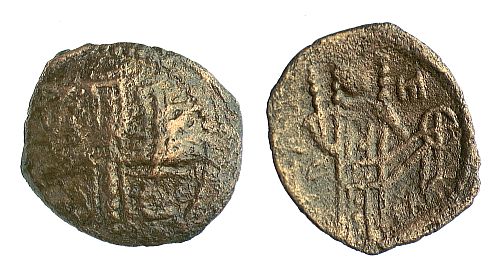The “Empire” of Trebizond
As Anatolia became increasingly under Turkish rule during the eleventh century, the city of Trebizond (modern Trabzon in the North East of modern Turkey) and its environs became like a Byzantine islet, albeit a rebellious one. Initially under the domination of the Gabras family, Trebizond began striking its own coins at the end of the eleventh century, despite being, at least theoretically, still part of the Byzantine Empire – the image and name of the emperor at Constantinople being usually omitted. All of these issues were of base metal and often polygonal in shape.
Following the capture of Constantinople by the Fourth Crusade in 1204, however, a branch of the Komnenian dynasty ruled the successor state known as the Empire of Trebizond (though the word ’empire’ may be an exaggeration). In the 1220s coin production at Trebizond restarted – having apparently paused after the beginning of the twelfth century – with the first named Trapezuntine Emperor being Andronikos I Komnenos-Gidon (1222-1235). Unlike at the other capitals, the mint of Trebizond produced only silver and base metal coins. The coins are Late Byzantine in design – showing the ruler standing, facing, wearing a loros and crown with pendilia, holding an akakia (a pouch of dust to which all men return) in the left hand and staff in the right, and being blessed by the manus dei (hand of God). On the obverse, however, is a figure unfamiliar to Byzantine coins: Saint Eugenios. Saints were well-known on Late Byzantine coins, so Eugenios’ appearance fits the pattern, but the saint himself was the patron saint of Trebizond, making the coins unmistakeably Trapezuntine.
Unlike the main Byzantine coin sections, which derive principally from the collection of Philip Whitting, half of the Barber’s coins of Trebizond come through the generous donations of Professor Anthony Bryer, a prominent scholar of the Byzantine Black Sea region, founder of the University of Birmingham’s Centre for Byzantine, Ottoman and Modern Greek Studies, and a significant individual in the donation of the main coin collection to the Barber. It is also from him that the Barber has obtained the majority of the lead seals collection, housed with the coins, which is almost exclusively Byzantine and largely Trapezuntine (find out more bout our seals collection).
For images of the coins mentioned, see the gallery to the right of this page.






